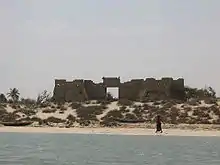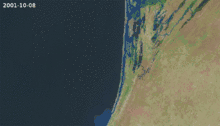Langue de Barbarie
The Langue de Barbarie (French for "Barbary spit of land", named after the Barbary Coast) is a thin, sandy peninsula, adjacent to the Atlantic Ocean, located in western Senegal, in the neighbourhood of the city of Saint-Louis.[1] The peninsula separates the ocean from the final section of the Senegal River.


National park
The Langue de Barbarie National Park (French: Parc National de la Langue de Barbarie) is located at the southern edge of the peninsula. Covering an area of 2,000 hectares (4,900 acres), it is home to an abundant variety of bird species and three species of turtle, including the critically endangered hawksbill sea turtle.[2][3]
2003 breach and environmental disaster

A 4 metres (13 ft) breach was cut in the peninsula near the city of Saint-Louis on 3 October 2003 to help counter possible flooding. However, the breach quickly widened to 800 m (2,600 ft) and separated the southern end of the peninsula permanently from the main country, effectively transforming it into an island.[4] As of December 2013 the sea has claimed over 3 km (1.9 mi) of land and has caused the loss of villages and tourist resorts in addition to changes in the flora and fauna of the peninsula.[5][6][7] By January 2020, the breach had widened to 6 km.[8]
References
- Deith, Jane (2007-05-05). "Senegal fights hunger to save birds". BBC News online. BBC. Retrieved 2007-08-08.
- "Parcs et réserves" (in French). Environment Ministry, Senegalese Government. 13 October 2005. Archived from the original on 2009-01-30. Retrieved 8 January 2014.
- "Parc National de la Langue de Barbarie". World Bird Database. BirdLife International. Retrieved 8 August 2007.
- "Le parc national de la Langue de Barbarie" (in French). Senegalaisement.com. 29 May 2009. Retrieved 20 October 2011.
- Grisot, Maureen (11 December 2013). "Près de Saint-Louis du Sénégal, la mer engloutit les villages". Le Monde (in French). Retrieved 5 January 2014.
- Triplet, Patrick; Benmergui, Maurice; Schricke, Vincent (2010). "Évolution de quelques espèces d'oiseaux d'eau dans le delta du fleuve Sénégal – Période 1989-2010" (PDF). Faune Sauvage (in French). 289: 6–13. Retrieved 8 January 2014.
- Durand, Paul; Anselme, Brice; Thomas, Yves-François (27 April 2010). "L'impact de l'ouverture de la brèche dans la langue de Barbarie à Saint-Louis du Sénégal en 2003 : un changement de nature de l'aléa inondation ?". Cybergeo : European Journal of Geography (in French). doi:10.4000/cybergeo.23017. Retrieved 8 January 2014.
- Pronczuk, Monika (2020-01-28). "How the 'Venice of Africa' is losing its battle against the rising ocean". The Guardian. ISSN 0261-3077. Retrieved 2020-01-29.
External links
| Wikimedia Commons has media related to Langue de Barbarie National Park. |
 Langue de Barbarie National Park travel guide from Wikivoyage
Langue de Barbarie National Park travel guide from Wikivoyage- Opening hours and pricing